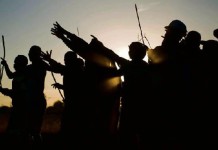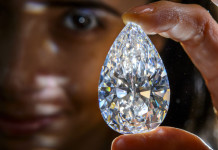
[miningmx.com] — WITH tears of joy continuing to flow as rescuers slowly pull each of the 33 men at a Chilean mine to the surface, the country’s President Sebastian Pinera cautiously warned that the saga isn’t over until all the men are out.
This comes just after the fourth miner, the lone Bolivian in the group, was rescued.
Carlos Mamani was greeted by his wife, Veronica, with a hug and kiss that knocked off her white hardhat as Pinera and the first lady held small Bolivian flags.
Mamani also gestured with both forefingers at the Chilean flag on his T-shirt and shouted “Gracias, Chile!” before a round of back-slapping with his rescuers.
Mamani had just started working as a heavy-equipment operator at the mine when it collapsed.
He was recruited by his father-in-law, Johnny Quispe, who told The Associated Press that he narrowly escaped being crushed himself when the rocks fell, and that everyone at the mine knew it was dangerously overworked.
Rescue should last 36 hours
Rescued first was Florencio Avalos, who wore a helmet and sunglasses to protect him from the glare of bright lights. He smiled broadly as he emerged and hugged his sobbing 7-year-old son, Bairon, and wife, then got a bearhug from Pinera shortly after midnight local time.
A second miner, Mario Sepulveda Espina, was pulled to the surface about an hour later – his shouts heard even before the capsule surfaced. After hugging his wife, Elvira, he jubilantly handed souvenir rocks from his underground prison to laughing rescuers.
Then he jumped up and down as if to prove his strength to everyone before the medical team took him into a triage unit.
A third miner, Juan Illanes, followed after another hour – holding to a schedule announced earlier to get them all out in about 36 hours.
When the last man surfaces, it promises to end a national crisis that began when 700 000 tons of rock collapsed on August 5, sealing the men in the lower reaches of the mine in the Chilean desert.
The miners captivated the world with their endurance and unity as Chile meticulously prepared their rescue.
After the first capsule came out of the manhole-sized opening, Avalos emerged as bystanders cheered, clapped and broke into a chant of “Chi! Chi! Chi! Le! Le! Le!” – the country’s name.
Avalos, the 31-year-old second-in-command of the miners, was chosen to be first because he was in the best condition.
He has been so shy that he volunteered to handle the camera rescuers sent down so he wouldn’t have to appear on the videos that the miners sent up.
“Never surrender’
Pinera later explained they had not planned for Avalos’ family to join rescuers at the opening of the shaft, but that little Bairon insisted on being there.
“I told Florencio that few times have I ever seen a son show so much love for his father,” the president said.
“This won’t be over until all 33 are out,” he added. “Hopefully the spirit of these miners will remain forever with us. … This country is capable of great things.”
“We made a promise to never surrender, and we kept it,” Pinera said as he waited to greet the miners, whose endurance and unity captivated the world as Chile meticulously prepared their rescue.
The last miner out has been decided: Shift foreman Luis Urzua, whose leadership was credited for helping the men endure 17 days with no outside contact after the collapse. The men made 48 hours’ worth of rations last before rescuers reached them with a narrow borehole to send down more food.
Janette Marin, sister-in-law of miner Dario Segovia, said the order of rescue didn’t matter.
“This won’t be a success unless they all get out,” she said, echoing the solidarity that the miners and people across Chile have expressed.
Medical rules
The paramedics can change the order of rescue based on a brief medical check once they’re in the mine.
First out will be those best able to handle any difficulties and tell their comrades what to expect.
Then, the weakest and the ill – in this case, about 10 suffer from hypertension, diabetes, dental and respiratory infections and skin lesions from the mine’s oppressive humidity. The last should be people who are both physically fit and strong of character.
Chile has taken extensive precautions to ensure the miners’ privacy, using a screen to block the top of the shaft from the more than 1 000 journalists at the scene.
The miners were ushered through a tunnel built of metal containers to an ambulance for a trip of several hundred metres to a triage station for a medical check. They will then be taken by helicopter to a hospital.
The only media allowed to record them coming out of the shaft will be a government photographer and Chile’s state TV channel, whose live broadcast was delayed by 30 seconds or more to prevent the release of anything unexpected. Photographers and camera operators were on a platform more than 90m away.
Prepared for problems
The worst technical problem that could happen, rescue co-ordinator Andre Sougarett told The Associated Press, is that “a rock could fall”, potentially jamming the capsule partly up the shaft.
Panic attacks are the rescuers’ biggest concern. The miners will not be sedated – they need to be alert in case something goes wrong. If a miner must get out more quickly, rescuers will accelerate the capsule to a maximum 3m per second, Health Minister Jaime Manalich said.
The rescue is risky simply because no one else has ever tried to extract miners from such depths, said Davitt McAteer, who directed the US Mine Safety and Health Administration in the Clinton administration.
A miner could get claustrophobic and do something to damage the capsule.
Or a falling rock could wedge it in the shaft. Or the cable could get hung up. Or the rig that pulls the cable could overheat.
“You can be good and you can be lucky. And they’ve been good and lucky,” McAteer told the AP. “Knock on wood that this luck holds out for the next 33 hours.”
Mining Minister Laurence Golborne, whose management of the crisis has made him a media star in Chile, said authorities had already thought of everything.
“There is no need to try to start guessing what could go wrong. We have done that job,” Golborne said. “We have hundreds of different contingencies.”
As for the miners, Manalich said, “It remains a paradox – they’re actually much more relaxed than we are.”











